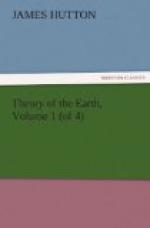He then illustrates this operation of nature by those of art, in building walls which certainly become hard, and which, as our author seems to think, become solid. But this is only an imperfect or erroneous representation of this subject; for, mortar does not become hard upon the principle of petrification adopted by our author. Mortar, made of clay, instead of lime, will not acquire a stony hardness, nor ever, by means of water, will it be more indurated than by simply drying; neither will the most subtile powder of chalk, with water and sand, form any solid body, or a proper mortar. The induration of mortar arises from the solution of a stony substance, and the subsequent concretion of that dissolved matter, operations purely chemical. Now, if this philosopher, in his Theory of Petrifaction, means only to explain a chemical operation upon mechanical principles, why have recourse, for an example in this subject, to mineral bodies, the origin of which is questioned? Why does he not rather explain, upon this principle, the known concretion of some body, from a fluid state, or, conversely, the known solution of some concreted body? If again he means to explain petrifaction in the usual way, by a chemical operation, in that case, the application of his polished surfaces, so as to cohere, cannot take place until the dissolved body be separated from the fluid, by means of which it is transported from place to place in the mineral regions. But it is in this preliminary step that lies all the difficulty; for, could we see how every different substance might be dissolved, and every dissolved substance separated from its solvent at our pleasure, we should find no difficulty in admitting the cohesion of hard bodies, whether by means of this doctrine of polished surfaces, or by the principle of general attraction, a principle which surely comprehends this particular, termed a cohesive power.
It must not be alleged, that seeing we know not how water dissolves saline bodies, therefore, this fluid, for any thing that we know, may also dissolve crystal; and, if water thus dissolves a mineral substance in a manner unknown to us, it may in like manner deposit it, although we may not be able to imagine how. This kind of reasoning is only calculated to keep us in ignorance; at the same time, the reasoning of philosophers, concerning petrifaction, does not in general appear to be founded on any principle that is more sound. That water dissolves salt is a fact. That water dissolves crystal is not a fact; therefore, those two propositions, with regard to the power of water, are infinitely removed, and cannot be assimilated in sound physical reasoning. It is no more a truth that water is able to dissolve salt, than that we never have been able to detect the smallest disposition in water to dissolve crystal, flint, quartz, or metals. Therefore, to allege the possibility of water being capable of dissolving those bodies in the mineral regions, and of thus changing the substance of one body into another, as naturalists have supposed, contrary to their knowledge, or in order to explain appearances, is so far from tending to increase our science, that it is abandoning the human intellect to be bewildered in an error; it is the vain attempt of lulling to sleep the scientific conscience, and making the soul of man insensible to the natural distress of conscious ignorance.




